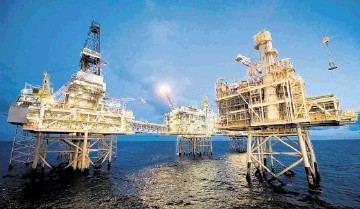
Each financial crisis seems to throw up its own new words and phrases – back in 2007 it was the term “credit crunch” and then came the dreaded phrases “sub-prime” and “collateralised debt obligations” or CDOs during the 2008-9 crash.
The subsequent foreign exchange trading scandals meant that suddenly everyone knew that “Libor” stood for the London inter-bank offered rate and that it had exotic-sounding cousins called “Hibor”, “Sibor” and even “Tibor”.
Now the plunge in the price of oil has brought another seldom-used word back into the headlines – “contango”.
Sadly this isn’t a new and exciting modified tango routine for the next series of Strictly Come Dancing but instead is a technical term used by commodities traders to describe when today’s spot price fell below future prices.
Over the past few days, the spot price of Brent crude for immediate delivery has fallen below the cost for future shipment, by more than $17 for February this year versus February 2017.
The last time the oil market entered contango was in the final quarter of 2009 as prices were beginning to recover following the financial crisis.
Contango has prompted oil companies to book super-tankers for up to 12 months at a time so that they can store their crude at sea in the hope that prices will start to rise again.
Vitol, the world’s largest standalone oil trader, has booked the TI Oceania, one of the four biggest ultra large crude carriers.
Measuring around 380 metres in length – that’s about four football pitches – the TI-class vessel can store about three million barrels of oil.
Vitol has also booked the Maran Corona, a very large crude carrier (VLCC) that can hold about two million barrels, while Switzerland-based trader Trafigura has hired the Nave Synergy VLCC and Shell is reported to have booked two VLCCs, the Xin Run Yang and Xin Tong Yang.
So far, super-tankers that can store about 15 million barrels in total are understood to have been booked by oil companies.
At the height of the 2009 contango, the figure is believed to have been at least 100 million barrels.
Firms are reported to have been able to secure older and less fuel-efficient tankers for about $40,000 a day, below current spot prices for ships of $60-70,000 and less than the peak cost of $97,000 reported in December, when traders were still hesitating to book vessels become of the expense involved.
But with oil prices still down by 50% compared with last August, the economics of storing oil are now beginning to add up once more.
During the last contango, freight rates were low, which meant that ship owners were happy to lease out their boats to oil companies and traders to store their crude.
But freight rates are currently rising, meaning that traders and suppliers may have to pay higher prices if they want to keep their oil out at sea.
The flurry of bookings for VLCCs and ULCCs has helped to give a fillip to shares in listed tanker operators. Frontline, Nordic American Tankers and Teekay Tankers have all seen the value of their stock rising in recent months while the oil price has continued to fall.
Mooring super-tankers off the coast could help oil prices to stabilise in the short-term.
Analysts at JBC Energy think that floating storage could bring a balancing effect to the market over the coming months, helping to support the price of crude.
Yet wider factors are still in play.
The well-rehearsed dampening effects on the oil price – with Saudi Arabia keeping OPEC output high and the United States’ shale industry having a longer-term impact – will not be solved by floating storage alone.
“Storing oil at sea will make money for the tanker companies and for those storing the oil, but it’s unlikely to have a bigger effect,” explained Clare Munro, head of the oil and gas team at law firm Brodies in Aberdeen.
“Saudi Arabia’s daily production alone is 9.6 million barrels, so even 100 million barrels in storage would only be a drop in the ocean.
While it might have a short-term effect on the oil price, it will soon be priced into the market and then the game is up.”
Yet analysts at JBC also highlight another improving trend, with China appearing to start stockpiling more oil to rebuild its reserves and also to help meet rising domestic demand.
While China won’t be able to absorb all of the global glut in crude, any extra barrels it buys will help to ease the concerns of those waiting to see the oil price bottoming out.
Instead, commentators are looking to the political ructions within Opec itself to see how long prices will remain depressed.
Saudi Arabia’s desire to keep production high and prices low is putting economic pressure on other members of the organisation – such as Nigeria and Venezuela – while output from Iraq and Libya is still being affected by violence within those countries.
Recommended for you
